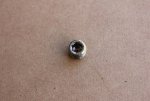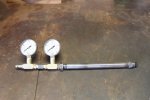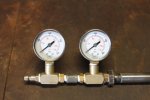Hi All
I built myself a leak down tester last night. I have attached a few pics. The pic with the 1/8" bung has a 1mm orifice drilled in the centre.
This orifice fits in-between the two gauges (in the Galv socket) to provide a pressure differential so that the amount of leakage can be determined in the cylinder.
I built myself a leak down tester last night. I have attached a few pics. The pic with the 1/8" bung has a 1mm orifice drilled in the centre.
This orifice fits in-between the two gauges (in the Galv socket) to provide a pressure differential so that the amount of leakage can be determined in the cylinder.



